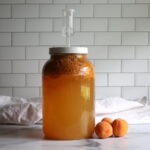Apricot Wine
Apricot wine seems to capture the essence of summer perfectly in a bottle. Adjust the sugar content to suit your tastes, or substitute honey for an apricot mead.
Servings: 20 glasses, Makes One Gallon (About 4 Bottles)
Equipment
- Air Lock & Stopper
Ingredients
- 2 to 3 lbs apricots chopped
- 2 to 3 pounds Sugar about 2 cups per pound
- 1 tsp yeast nutrient
- 2 tsp acid blend
- ⅛ tsp tannin powder
- 1 packet wine yeast see note
- Optional ~ Campden Tablet and Potassium Sorbate for Stabilizing I do not use these
Instructions
- Begin by removing the pits from the apricots and chopping them up into smaller sections.
- Move apricots to a large bowl and cover them with sugar. Stir them regularly to ensure the sugar covers all sections and helps to extract the juice. Wait 12 to 24 hours for the juice to extract.
- Once the juice has been extracted, strain the apricot juice into your primary fermentation vessel. (Or use a wide-mouth fermenter and include the pulp in primary to extract a bit more flavor. The fruit will need to be strained before secondary. Placing the fruit in a brewing bag can help keep things clean. Do not include the fruit pulp if using a standard narrow-neck fermenter, as it will clog the water lock and make a mess.)
- Add some water to the bowl that the apricots were left to juice in. Strain this and pour it into your primary fermentation vessel to make sure the last of the sugar and apricot juice make it in as well.
- Add your wine tannin, acid blend, and yeast nutrient. Add enough water to bring the level to ¾ full.
- Add the wine yeast last. Rehydrate in a small amount of room temperature water (about ¼ cup) for 10 minutes and add to the carboy. Stir ingredients to incorporate.
- Top with enough water to bring the level up to just below the neck of the carboy and seal with a water lock.
- Allow to ferment in primary for 10 to 14 days.
- Siphon the mixture to a clean carboy, leaving sediment behind. (And also leaving any fruit pulp behind if you included the fruit in primary.)
- Top it up with water, seal it with a water lock, and let it ferment in secondary for at least 6 weeks. For the best wine, ferment in secondary for 3 to 6 months.
- At the end of secondary, sample the wine. Adjust to taste (see notes for info on backsweetening).
- Rack the wine into wine bottles and seal with wine corks. Let wine bottle-age at least 1 month before drinking (and preferably for a year for the best result).
Notes
Apricot Mead
To make apricot mead, substitute 1 quart (3 lbs) of honey for the sugar. You’ll need to crush the fruit to extract the juice and strain it through a fine mesh strainer before adding it to the carboy. Note, the time spent in secondary may be longer than for wine, as the honey is harder for yeast to digest than sugar.Yeast
For apricot wine, choose a wine yeast with moderate alcohol tolerance, that ferments clean or adds light fruit flavors. Premier Blanc wine yeast is preferred but Lalvin 71B or Cotes des Blanc are also good choices. Stabilizing and Back Sweetening ~ If you sample your wine at the end of secondary and find it too dry, you can always backsweeten to counteract this. To backsweeten, rack the wine to a clean container and stabilize it by adding 1 Campden tablet and ½ teaspoon potassium sorbate to kill the yeast and stop the ferment. Adding sugar may restart fermentation and cause bottled wine to burst if not stabilized first. Wait 24 to 48 hours after stabilizing before adding sugar. Add sugar in the form of a simple syrup made by heating equal parts sugar and water. For a one-gallon batch of apricot wine, I suggest starting with ½ cup sugar when backsweetening. After adding sugar, reseal the water lock and put it back into ferment for a week before bottling. See notes within the article for more information regarding stabilizing and back sweetening.Nutrition
Calories: 197kcal | Carbohydrates: 50g | Protein: 1g | Fat: 0.3g | Saturated Fat: 0.01g | Polyunsaturated Fat: 0.03g | Monounsaturated Fat: 0.1g | Sodium: 1mg | Potassium: 119mg | Fiber: 1g | Sugar: 49g | Vitamin A: 874IU | Vitamin C: 5mg | Calcium: 6mg | Iron: 0.2mg
